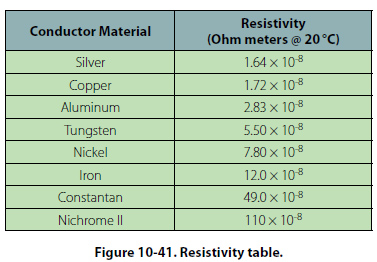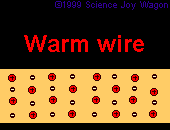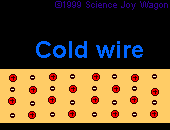Electrical Resistance
Electrical Resistance is the measure of how difficult it is for a current to pass through a conductor.
This quantity often measured in ohms [math]\displaystyle{ \Omega(\frac{Volts}{Amps}) }[/math] is used to determine the amount of current that will pass through a circuit. Resistance itself is dependent on a variety of factors including material, shape, and temperature. In most applications the resistance of a wire is assumed to be zero.
The Main Idea
State, in your own words, the main idea for this topic Electric Field of Capacitor
A Mathematical Model
Resistance is often expressed in the following form [math]\displaystyle{ R = \frac{\rho L}{A} }[/math] where R is the resistance [math]\displaystyle{ \rho }[/math] is the resistivity L is the length and A is the cross-sectional area.
In a circuit the Electrical Resistance is often calculated using Ohm's law [math]\displaystyle{ R = \frac{|\Delta V|}{I} }[/math] Often written [math]\displaystyle{ I = \frac{|\Delta V|}{R} }[/math] where V is the voltage and I is the current and R is the resistance. In these equations voltage and resistance are independent variables and Current is the dependant variable. This law, while useful, only works for certain resistors called ohmic resistors.
Water Analogy
Electrical Resistance in a particular material is often compared to a pipes of varying diameter. The larger the pipe the easier it is for water to get through. This is equivalent to lower resistance in electricity.
Resistivity of Materials
Every conductor has a natural resistivity that it relatively consistent at a given temperature. This number is calculated through experimentation. Here is a list of common conductors and their resistivity.
 (http://avstop.com/ac/Aviation_Maintenance_Technician_Handbook_General/10-19.html)
(http://avstop.com/ac/Aviation_Maintenance_Technician_Handbook_General/10-19.html)
Temperature
In addition to each material having a different resistivity. The same materials at different temperatures have different resistivities. As materials heat up it becomes harder and harder for current to pass through them. This is because at the sub-atomic level. The nuclei are moving faster making it harder for electrons to move through.
Examples
3 examples of potential problems involving resistance.
Simple
Question
An unknown ohmic resistor is attached to a 3V battery and the current is measured at 1 amp. Calculate the resistance of the unknown resistor.
Answer
Using the equation I=|dV|/R we can substitute is 1 for I and 3 for dV leaving us with the equation 1=3/R. Solving for R we come to the answer that the it must be a 3 ohm resistor.
Middling
Question
A cylinder of an unknown material has a resistance of 30 ohms. Another cylinder made of the exact same material is twice as long and has a radius that is twice as large. What is the resistance of this cylinder.
Answer
Given the equation [math]\displaystyle{ R = \frac{\rho L}{A} }[/math] we know that when the length is doubled the resistance must also double. In addition we know that when the radius is doubled, the cross section area must go up by a factor of 4. This means that the resistance would go down by a factor of 1/4. Putting both of those facts together know that R2 = R1 * 2 * 1/4 or R2 = 15 ohms.
Difficult
Question
A battery and resistor circuit is connected to a very sensitive ohmmeter is taken outside and left in the sun on a very hot day. what if anything will happen to its reading after being outside for a few minutes and why. Assume the battery is unaffected.
Answer
The current would be less that it was inside. Since the circuit was taken outside the resistor would heat up due to the sun. This would in turn cause its resistance to go up. When the resistance goes up and the voltage of the battery stays the same. due to Ohms Law the current must go down, resulting in a lower reading.
Connectedness
- How is this topic connected to something that you are interested in?
- How is it connected to your major?
- Is there an interesting industrial application?
History
Put this idea in historical context. Give the reader the Who, What, When, Where, and Why.
See also
Are there related topics or categories in this wiki resource for the curious reader to explore? How does this topic fit into that context?
Further reading
Books, Articles or other print media on this topic
External links
Helpful Links
1. http://hyperphysics.phy-astr.gsu.edu/hbase/electric/resis.html
2. http://www.britannica.com/technology/resistance-electronics
3. http://www.cleanroom.byu.edu/Resistivities.phtml
4. http://www.nist.gov/data/PDFfiles/jpcrd155.pdf
5. http://www.regentsprep.org/Regents/physics/phys03/bresist/default.htm
Helpful Videos
1. https://www.youtube.com/watch?v=-PJcj1TCf_g
2. https://www.youtube.com/watch?v=J4Vq-xHqUo8
References
This section contains the the references you used while writing this page


